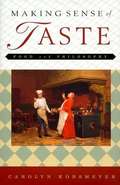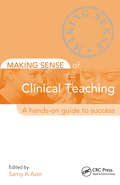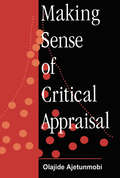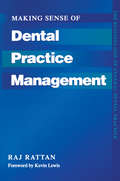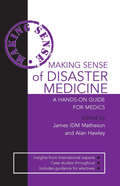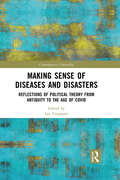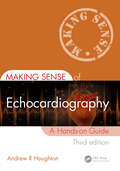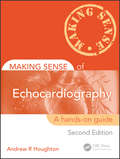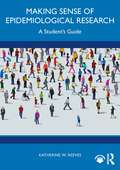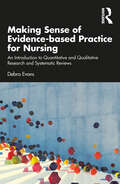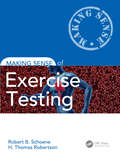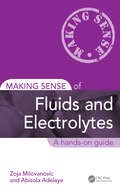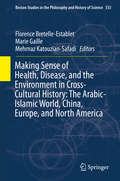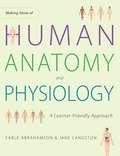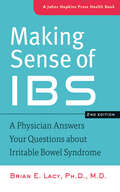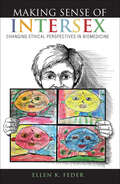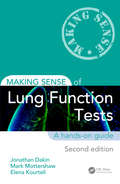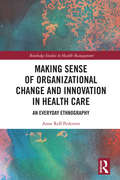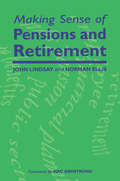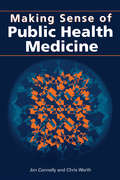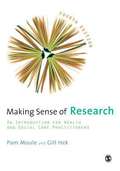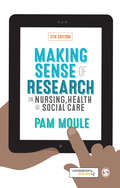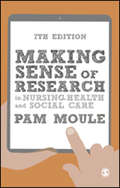- Table View
- List View
Making Sense Of Taste
by Carolyn KorsmeyerKorsmeyer (philosophy, State U. of New York-Buffalo) disagrees with the centuries of philosophers before her that taste is beneath the dignity of the field. She explores how it gained such a low esteem, parallels between notions of aesthetic and gustatory taste, how the sense works scientifically, the multiple components of the experience, its various meanings in art and literature, and its sacred dimension. Annotation copyrighted by Book News, Inc. , Portland, OR
Making Sense of Clinical Teaching: A Hands-on Guide to Success (Making Sense Of Ser.)
by Mph PhD Samy A Azer MEd Unsw FacgAre you new to clinical teaching and looking for practical advice? Would you like to challenge and improve your current teaching style? Do you want to direct change in teaching practice within a department or institution?If your answer to any of the above is yes, then Making Sense of Clinical Teaching is the resource for you. It offers the novice a
Making Sense of Critical Appraisal (Making Sense Of Ser.)
by Olajide AjetunmobiThis handy pocket companion provides all the necessary guidance on how to understand medical research publications, read them critically and decide whether the content of those papers is clinically useful in the care of patients. Illustrated throughout with medically relevant examples, the accessible text encompasses all relevant aspects of study design and clinical audit to give a clear framework to support critical reading for the novice and more experienced reader.
Making Sense of Dental Practice Finance
by Mervyn Bright Sau-Kee LiThe training and culture of dental practice is based on clinical treatment and patient care. However in order to run their practices efficiently dentists and their staff must have business acumen and knowledge for which most are unprepared. This clear and authoritative guide presents the facts of practice finance explains how practice income can be maximised through its various sources and identifies the pitfalls and opportunities for further development. The 'New Contract' and reforms to the NHS system emphasize the need for the dental profession to respond effectively to the changed environment and this concise and comprehensive reference has been designed to meet this need.
Making Sense of Dental Practice Management
by Kevin Lewis Raj RattanManaging a dental practice has become increasingly complex in recent years, after changes within both the National Health Service and the private sector. Modern dental practice requires that dentists meet demanding business and management challenges as well as employing their clinical expertise. However, most dentists receive little or no formal training in practice management. In this book established management principles are applied specifically to dentistry. It shows how to best serve the interests of patients by effective management of staff, finances, premises and resources. It assumes no prior knowledge, is concise and offers clear, practical advice. It is the definitive guide for dentists, vocational trainees, dental students, practice managers and administrators, and a useful reference for those undertaking the DGDP and MGDS examinations.
Making Sense of Disaster Medicine: A Hands-on Guide for Medics
by Alan Hawley James MathesonDisaster medicine is a broad and dynamic field that encompasses the medical and surgical response to mass casualty incidents including rail, air, and road traffic accidents; domestic terrorism; and pandemic outbreaks. It also encompasses the global issues of conflict and natural catastrophe. Specialists in disaster medicine provide insight, guidanc
Making Sense of Diseases and Disasters: Reflections of Political Theory from Antiquity to the Age of COVID (Contemporary Liminality)
by Lee TrepanierThis book examines diseases and disasters from the perspective of social and political theory, exploring the ways in which political leaders, social activists, historians, philosophers, and writers have tried to make sense of the catastrophes that have plagued humankind from Thucydides to the present COVID pandemic. By adopting the perspective of political theory, it sheds light on what these individuals and events can teach us about politics, society, and human nature, as well as the insights and limitations of political theory. Including thinkers such as Thucydides, Sophocles, Augustine, Bacon, Locke, Hume, Rousseau, Publius, Bartolomé de las Casas, Jane Addams, Camus, Saramago, Baudrillard, Weber, Schmitt, Voegelin and Agamben, it considers a diverse range of events including the plagues of Byzantium and 14th century Europe, 9/11, the hurricanes of Fukushima, Boxing Day, and New Orleans, and the current COVID pandemic. An examination of past, present, and future diseases and disasters, and the ways in which individuals and societies react to them, this volume will appeal to scholars of politics, sociology, anthropology and philosophy with interests in disaster and the social body.
Making Sense of Echocardiography: A Hands-on Guide (Making Sense of)
by Andrew R. HoughtonEchocardiography is one of the most useful and powerful diagnostic tools in the assessment of cardiac structure and function. It remains a rapidly expanding modality, with new techniques constantly developing and maturing. Building on the success of the second edition, the third edition of Making Sense of Echocardiography: A Hands-on Guide provides a timely overview for those learning echocardiography for the first time as well as an accessible handbook that experienced sonographers can refer to. The strong clinical focus and concentration on real-life scenarios make this book relevant in day-to-day practice. Key updates for this edition include the latest guidelines for the evaluation of diastolic function and pulmonary hypertension, and fully updated reference intervals throughout. Key Features:• Covers not only the fundamentals of echocardiography including ultrasound physics, but also covers new technologies such as 3D echocardiography.• Provides a comprehensive approach for the echo trainee and also serves as a useful reference for more seasoned echocardiographers.• Incorporates current guidelines and reference intervals throughout.
Making Sense of Echocardiography: A Hands-on Guide, Second Edition (Making Sense Of Ser.)
by Andrew R HoughtonEchocardiography is one of the most useful and powerful diagnostic tools in the assessment of cardiac function. It remains a rapidly expanding modality, with new techniques constantly developing and maturing. Building on the success of the original work, the second edition of Making Sense of Echocardiography: A Hands-on Guide provides a timely, acc
Making Sense of Epidemiological Research: A Student's Guide
by Katherine W. ReevesUsing clear language and real-world examples, this accessible textbook provides a concise guide to the understanding and critical evaluation of journal articles in epidemiology.The book offers a step-by-step process, beginning with how to find epidemiologic studies on a given topic. It then shows readers how to identify and assess the key features of a study’s design, the methods of data collection and analysis, the conclusions that can be drawn, and finally the questions that remain. Including a chapter exploring the misuse of artificial intelligence, this complete companion shows students not only how to evaluate individual studies but also to synthesize findings across multiple studies on a single topic, as well as guidance on writing a critique of a given article.Written by an experienced instructor with over 15 years of experience teaching, and including activities so that readers can practice the skills they learn, this will be essential reading for any student of epidemiology, public health, and medicine.
Making Sense of Evidence-based Practice for Nursing: An Introduction to Quantitative and Qualitative Research and Systematic Reviews
by Debra EvansThis straightforward guide to evidence-based practice helps you to develop the knowledge and skills necessary to challenge practice that is not underpinned by research and to increase your understanding of the processes involved in accessing, appraising, and synthesizing good quality research. Providing a basic introduction to both quantitative and qualitative research, Debra Evans explores how to find out “what works best”, the impact of something, and what requires more research. Readers will also learn the basic rules used in study design and statistics presented in research articles and systematic reviews. Each simply written chapter includes relevant theory, diagrams and tables, case studies, exercises, boxed summaries, and further reading. Packed with examples from practice across the nursing fields and at different levels, this book is essential for nurses – both student and qualified – who want to increase their confidence when it comes to research appraisal and evidence-based practice processes.
Making Sense of Exercise Testing (Making Sense of)
by H. Thomas Robertson Robert B. SchoeneThis book makes sense of complex topics by distilling them to basic concepts. It provides normal physiology integrated with indications for and evaluation of disease states. With a fresh clinical approach, it helps answer reoccurring questions.
Making Sense of Fluids and Electrolytes: A hands-on guide (Making Sense of)
by Zoja Milovanovic Abisola AdeleyeInterpreting the fluid requirements of a patient and working out what to do next can seem like a daunting task for the non-specialist, yet it is a skill that any doctor, nurse or paramedic needs to be fully appraised of and comfortable with. Making Sense of Fluids and Electrolytes has been written specifically with this in mind, and will help the student and more experienced practitioner working across a variety of healthcare settings to understand why fluid imbalance in a patient may occur, to assess quickly a patient's fluid needs through a thorough clinical assessment and to develop an effective management plan. Reflecting the latest guidelines, this practical, easy-to-read and easy-to remember guide will be an invaluable tool to aid speedy and appropriate management in emergency situations, on the ward and in the clinic.
Making Sense of Health, Disease, and the Environment in Cross-Cultural History: The Arabic-Islamic World, China, Europe, and North America (Boston Studies in the Philosophy and History of Science #333)
by Florence Bretelle-Establet Mehrnaz Katouzian-Safadi Marie GailleThis book has been defined around three important issues: the first sheds light on how people, in various philosophical, religious, and political contexts, understand the natural environment, and how the relationship between the environment and the body is perceived; the second focuses on the perceptions that a particular natural environment is good or bad for human health and examines the reasons behind such characterizations ; the third examines the promotion, in history, of specific practices to take advantage of the health benefits, or avoid the harm, caused by certain environments and also efforts made to change environments supposed to be harmful to human health. The feeling and/or the observation that the natural environment can have effects on human health have been, and are still commonly shared throughout the world. This led us to raise the issue of the links observed and believed to exist between human beings and the natural environment in a broad chronological and geographical framework. In this investigation, we bring the reader from ancient and late imperial China to the medieval Arab world up to medieval, modern, and contemporary Europe. This book does not examine these relationships through the prism of the knowledge of our modern contemporary European experience, which, still too often, leads to the feeling of totally different worlds. Rather, it questions protagonists who, in different times and in different places, have reflected, on their own terms, on the links between environment and health and tries to obtain a better understanding of why these links took the form they did in these precise contexts. This book targets an academic readership as well as an “informed audience”, for whom present issues of environment and health can be nourished by the reflections of the past.
Making Sense of Human Anatomy and Physiology: A Learner-Friendly Approach
by Earle Abrahamson Jane LangstonDesigned to be user-friendly and informative for both students and teachers, this book provides a road map for understanding problems and issues that arise in the study of anatomy and physiology. Students will find tips to develop specific study skills that lead to maximum understanding and retention. They will learn strategies not only for passing an examination or assessment, but also for permanently retaining the fundamental building blocks of anatomical study and application. For the teacher and educator, the book provides useful insight into practical and effective assessment techniques, explores the subject matter from a learning approach perspective, and considers different methods of teaching to best to convey the message and meaning of anatomy and physiology. Supported by clear diagrams and illustrations, this is a key text for teachers who want a useful toolbox of creative techniques and ideas that will enhance the learning experience. In addition to the wealth of information it provides, Making Sense of Human Anatomy and Physiology sets in place a bedrock of learning skills for future study, regardless of the subject. Students of beauty therapies, holistic and complementary therapies, and fitness professionals--yoga teachers, personal trainers, sports coaches, and dance teachers--will gain not only a basic understanding of anatomy and physiology, but also the skills to learn such a subject. Allied professionals in nursing, biomedical science, dentistry, occupational therapy, physiotherapy, midwifery, zoology, biology and veterinary science will also find this book an invaluable resource. The final chapters offer suggestions for the further exploration of concepts, assessment, learning activities, and applications.
Making Sense of IBS: A Physician Answers Your Questions about Irritable Bowel Syndrome (A Johns Hopkins Press Health Book)
by Brian E. LacyVital information about new treatments and dietary factors affecting irritable bowel syndrome.IBS, which affects almost one in six Americans, is characterized by abdominal pain, bloating, gas, and diarrhea or constipation. Today more than ever before, physicians are able to diagnose this complex disorder, understand and explain its origins, and develop a treatment plan that effectively meets the individual needs of a patient.Drawing on his many years of experience treating people who have symptoms of IBS, Dr. Brian E. Lacy explains normal digestion, the causes of IBS, how IBS is diagnosed, and what to expect with treatment. He also explores special topics such as IBS in children and psychological, hypnotherapeutic, and psychiatric therapies. Important new information in the second edition includes• The roles of fiber, gluten, lactose, and fructose in the development and treatment of IBS• The use of probiotics and antibiotics to treat IBS• Similarities and differences between IBS and inflammatory bowel disease (IBD)• The relationship between small intestine bacterial overgrowth and IBS• How to make the most of your visits to a gastroenterologist• Lifestyle modifications that can improve symptoms of IBSMaking Sense of IBS is an essential resource for anyone who has symptoms or a diagnosis of IBS as well as for health professionals who treat people with this complex disorder.
Making Sense of Intersex: Changing Ethical Perspectives in Biomedicine
by Ellen K. FederA philosopher offers a framework for the treatment of intersex children, and a moral argument for responsibility to them and their families.Putting the ethical tools of philosophy to work, Ellen K. Feder seeks to clarify how we should understand “the problem” of intersex. Adults often report that medical interventions they underwent as children to “correct” atypical sex anatomies caused them physical and psychological harm. Proposing a philosophical framework for the treatment of children with intersex conditions—one that acknowledges the intertwined identities of parents, children, and their doctors—Feder presents a persuasive moral argument for collective responsibility to these children and their families.“In a voice both urgent and nuanced, Feder squarely faces the complexities that accompany the care of people with atypical sex anatomies in medical science. . . . Rich with cross-discipline potential, Feder’s engaging argument should provide a new approach for doctors and parents caring for children with atypical sex anatomy.” —Publishers Weekly, starred review“Feder’s book is a welcome injection of new ideas into feminist scholarship on intersex, post-Consensus Statement era.” —Women’s Review of Books“Is a work of philosophy capable of bringing insightful new perspectives or illuminating and forceful arguments to an urgent social matter so as truly to effect a felt change in the lives of people concerned by it? Feder’s book is capable of this effect. As such, it takes the risk of calling forth a new public, or a new readership, and so is a work whose appeal could well be ahead of its time. But its time should be here.” —International Journal of Feminist Approaches to Bioethics“Making Sense of Intersex significantly enhances our understanding of intersex and the ethical issues involved in medical practice more generally.” —Kennedy Institute of Ethics Journal
Making Sense of Lung Function Tests (Making Sense of)
by Jonathan Dakin Mark Mottershaw Elena KourteliRespiratory problems are the most common cause of acute admission to hospital. A variety of diagnostic investigations are required, both for acute and clinic assessment. Making Sense of Lung Function Tests, Second Edition familiarises both trainees and more experienced clinicians with the interpretation of a range of respiratory parameters. It places lung function in a clinical context using real-life examples and provides invaluable hands-on guidance. For this second edition Consultant Respiratory Physician Jonathan Dakin and Consultant Anaesthetist Elena Kourteli are joined by Mark Mottershaw, Chief Respiratory Physiologist from Queen Alexandra Hospital, Portsmouth, all contributing a broad range of expertise and perspectives. Together they have updated the book throughout and added new chapters including an algorithm for interpretation of pulmonary function tests, exhaled nitric oxide (FENO) and cardiopulmonary exercise testing. The text offers a clear explanation of the concepts which students find difficult, including: The basis of obstructive and restrictive defects Pattern recognition of the flow volume loop Differences between TLCO and KCO Assessment of oxygenation using PO2 and SO2 The basis of Type 1 and type 2 respiratory failure Distinguishing respiratory and metabolic acidosis The relationship between sleep and respiratory failure The information is presented in an accessible way, suitable for those seeking a basic grounding in spirometry or blood gases, but also sufficiently comprehensive for readers completing specialist training in general or respiratory medicine.
Making Sense of Organizational Change and Innovation in Health Care: An Everyday Ethnography (Routledge Studies in Health Management)
by Anne Reff PedersenThis book explores the hospital via organisational ethnography (OE), an approach that involves a mix of fieldwork methods designed to analyse the hospital which also includes participatory observation, qualitative interviews and shadowing. One way to define a hospital is by its high level of formal organisation, resulting in written or digital communication as the main source of communication in patient journals, minutes and medical and quality guidelines. In contrast, in this book, the aspects of the informal organisation will be the focus. In spite of the many formal regulations of healthcare, hospitals are also chaotic organising places where many different groups of people interact in order to negotiate, to practice and to make sense of daily work tasks. The underlying argument is that, in the mundane everyday life of hospitals, frontline workers and their interactions with patients and local managers remain at the core of organising hospitals. The overall purpose of this book is to report stories back from the field of healthcare, demonstrating how people, spaces and work (as examples of events) become important elements of organising hospitals. The book will be of interest to students and scholars in and across healthcare management, organisation studies, ethnography, sociology, qualitative methods, anthropology, service management and cultural studies.
Making Sense of Pensions and Retirement
by Norman Ellis John LindsayThe NHS pension scheme is the largest in Europe. This guide explains how it works and how to maximize its benefits and avoid its pitfalls. The book covers: recent changes to the scheme including new provisions for early retirement; personal pensions, financial planning and investment options; advice on preparing for retirement and working after retirement; state benefits; and health and leisure in retirement. It is written for all NHS staff and should be of particular value to GPs and salaried doctors.
Making Sense of Planning and Development for the Post-Pandemic Cities (City Development: Issues and Best Practices)
by Kh Md NahiduzzamanThis book holds a distinguished promise of an intellectual understanding and complete account of that shifts in laying out resilient planning, development, and policy landscapes for the cities to come. The approach offers a unique perspective on planning and development in the post-pandemic era, addressing the interconnectedness of diverse spatial, social, cultural, economic, demographic, and political aspects. It provides insights into the transformational behavior of cities and citizens, explores the influence of remote work on the real estate market, emphasizes the need for resilient infrastructure and adaptive planning, and reinforces the association between health infrastructure and planning for resilient cities. The book provides a comprehensive account of the shifts and challenges faced in planning and development due to climate change and the COVID-19 pandemic. It explores transformational urban planning, sociocultural, and economic landscapes and addresses topics, including land use changes, transformational real estate market, urban recreational space, adaptive infrastructure, and the need for resilient planning. It offers valuable insights for urban designers, architects, geographers, city planners, policymakers, and pubic officials seeking to enhance city resilience in the post-pandemic era. The intended readership of the book includes urban designers, architects, city planners, geographers, policy makers, and public officials. It caters to individuals interested in gaining a critical understanding of the interconnectedness between various spatial, social, cultural, economic, demographic, and political aspects. The content level is academic, offering scholarly insights and a unique post-pandemic perspective on enhancing city resilience.
Making Sense of Public Health Medicine
by Jim Connelly Chris WorthThis book presents an introduction to modern public health seen from the perspective of practitioners of public health medicine. Written for non-practitioners interested in public health and as an essential introduction for those considering a career in public health medicine, the book uses illustrative case studies to demonstrate the practical application of public health techniques. In demonstrating the value of this approach, the book argues for the adoption of a realist health policy and radical reform of clinical medicine - to achieve public health. The skills of public health physicians are central to planning health services, purchasing effective and cost-effective treatments, and improving the quality of services. It is vital that those who plan and deliver health care understand their work and appreciate their contribution. This book describes that contribution, and provides a powerful analysis of the challenges the NHS and the wider community face in improving health.
Making Sense of Research
by Pam MouleTo help health and social care professionals develop research literacy, this introductory text overviews the relevant elements of evidence-based practice from key terms and concepts to research dissemination and implementation. The text includes highlighted key points, further reading, appended material on conducting literature searches and appraising a study, and a glossary. The references include a listing for each of the authors; that of Moule is her doctoral thesis at the U. of the West of England, Bristol. Hek's professional affiliation is not given. A Web search shows the dates of previous editions to be 2002 and 1996. Annotation ©2006 Book News, Inc. , Portland, OR (booknews. com)
Making Sense of Research in Nursing, Health and Social Care
by Pam MouleWhat is research? Why is it important in health and nursing? How should students use evidence in practice? This short and simple book for those who are completely new to research will answer all your students' questions about the subject. It will help them to make sense of the various and often confusing research methods and terminology, to read and appraise literature and to understand how research is implemented in practice. It features: · Case examples of real research from a variety of settings and a range of countries so that students can see how research applies to the real world · Tools, examples and frameworks to help students to find, appraise and critique research · Chapter learning outcomes and key points to help students to remember important information · A companion website with interactive glossary and reflective exercises to help students test their knowledge and apply it to practice, printable step-by-step frameworks for use when searching for or critiquing a paper, and direct links to relevant SAGE journal articles and weblinks. · Further resources for lecturers are available, including all the practice examples from the book, seminar question ideas and critical appraisal powerpoints. The book is essential reading for undergraduate and postgraduate students of nursing and health in the UK and internationally.
Making Sense of Research in Nursing, Health and Social Care
by Pam MouleWhat is research and how does it work in the context of nursing, health and social care? This introductory guide provides you with a concise overview of the different research methods and terminology that you will come across when undertaking research in any course related to nursing, health and social care. The book′s easy-to-follow structure takes you from research novice to confident researcher, helping you to make sense of research and understand how it is implemented in healthcare practice. The new edition includes: Updates in light of the 2018 NMC standards, with more information on the impact of GDPR, consent and vulnerable groups, Personal and Public Involvement (PPI), and work-based projects. Improved case examples of real research, with more on group work, poster presentations, research output and dissemination, literature reviews, and dissertations. Upgraded activities that include reflective exercises, critical appraisal tools, a dissemination plan, and a glossary, all in the book. This is essential reading for undergraduate and postgraduate students within the health and therapy professions, nurses, midwives, physiotherapists, radiographers, occupational therapists, speech and language therapists, and paramedics.
